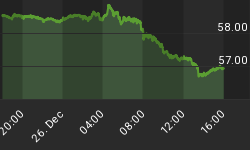It has been a while since I felt compelled to see if Mr. Stratton would be so kind as to publish the opinion of this small investor. The last time was late last fall, just after the Refco meltdown. I felt that event exemplified the increasing counterparty risk that derivatives investors would face, and I wanted to point out the value of precious metals investments, especially physical, in such a financial climate. The recent spike rise in that sector was just getting started then. Just how much the Refco debacle actually contributed to that, I do not know, but it was a good time to be buying gold and silver anyway.
Now, metals prices have given up much of the gains since that time and sentiment in the sector is getting rather gloomy. However, I recently read an article, An "Interesting" Picture Of The US Bond Markets by Pinank Mehta, which I believe may give a peak behind the wizard's curtain to expose the "invisible hand" at work helping to create the politically correct (on Wall Street) image of a strong economy.
I first learned of this article from Mike Hartman in his market roundup of Wednesday, 10/11/06 at http://www.financialsense.com
The original article by Pinank Mehta can be found at http://www.gold-eagle.com/editorials_05/mehta100706.html It is concise, and you should read it before continuing with the rest of this piece.
Mehta doesn't speculate as to the reason for this highly suspect (12 sigma!: statistically virtually impossible) level of open interest in 10 year treasuries, but Mike Hartman's view is that it has something to do with containing the damage from a bursting housing bubble. I believe that is credible.
My speculation is that this, along with falling oil and commodity prices, may be at least partly due to a desire by the large financial houses and energy producers to shore up the beleaguered ruling Republicans before the midterm elections. That speculation is, I suppose, a bit more tenuous, but I do firmly believe it is true.
Anyway, whatever the causes, the bottom line here is what does it mean for investors, and I believe Mehta is nearly right-on in his recommendation of "defensive steps". The following, in blue, is cut and pasted from his article.
Some of the defensive steps:
- Unwind leverage in the portfolio
- Get out of long-dated debt preferably into the highest quality / sovereign short-term debt. Do not hold paper you do not intend to hold to maturity.
- Pare down exposure to aggressive equities.
- Hold investments that you intend to hold for the long term (at least 2 years) only.
- Temporarily move out of synthetic instruments (structured paper, hedge funds, OTC derivatives, Fund of Funds, etc
I hasten to add here though that Federal Reserve notes and their equivalents represent nothing but debt monetized over and over again and unconstitutionally stripped of its original gold backing to boot.
Therefore, besides the defensive measures mentioned by Mehta, I think it is prudent at this point to keep a goodly portion of one's wealth in the form real money, i.e., physical precious metals, as well as to have some gold and silver mining equities in one's stock portfolio.
Nevertheless, cash IS safer than many other types of even more "structured paper" and in the opinion of some deflationists, such as Robert Prechter, could even be the ONLY asset class to appreciate in value when the debt pyramid collapses. I'm a bit skeptical of that view, but I do have quite a substantial cash "hedge" to my portfolio of bullion and commodity stocks anyway.
I know that now with the Dow at all time highs, energy prices easing and commodities markets in general in or near technical breakdown, it is beginning to look like precious metals and commodity investors are in for a long losing streak. However, peaking behind the curtain, one can see signs such as the one discussed in the articles linked to here which point to desperate efforts on the part of the financial "powers that be" to keep the debt pyramid shell game going. This should continue to fuel the flight from paper to tangibles.
On a technical note, my amateur's eye sees a possible bearish wedge throw over in progress in several major stock indices. At least, there is an upper trend channel break taking place. I suppose it could be the beginning of a new power uptrend in stocks. But with the housing bubble situation what it is, I remain highly suspicious that it is a throw over -- something that often precedes a sharp reversal.
Will "the powers that be" allow a trend reversal before the election? Can they keep the market propped up, if indeed they are doing so, until Nov. 7? I sure wish I knew, but given the Bush family and administration's close ties with the House of Saud and the energy industry in general, I wouldn't be surprised if they can at least keep energy prices down for a while, and that might be enough to keep stocks rising.
But what about after the elections?
Like most everybody else I know very little for sure, especially what the future holds. However, I have a hunch that several markets will be experiencing trend reversals in the very near future. That means I expect the secular trends of general equities down (in real, inflation adjusted terms, at least) and commodities up to reassert themselves soon, possibly with a vengeance.
















